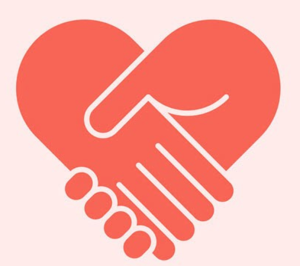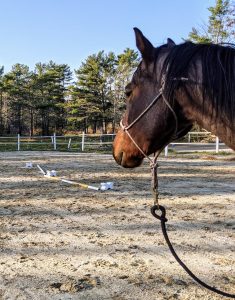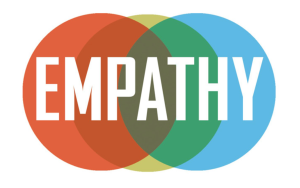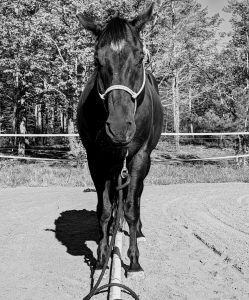Editor’s Note: Julie Kenney is an avid horsewoman, former Best Horse Practices Summit board member, and runs Blackberry Farm in Harpswell, Maine.
Julie writes:
 My mind meanders during times of deep relaxation. At a recent massage therapy session, it floated like a kite tethered to me in a light wind. I usually picture each muscle that is being stretched and softened, but this time I imagined how similar the experience was to how I like to handle my horses.
My mind meanders during times of deep relaxation. At a recent massage therapy session, it floated like a kite tethered to me in a light wind. I usually picture each muscle that is being stretched and softened, but this time I imagined how similar the experience was to how I like to handle my horses.
Most of us have experienced some form of therapy, be it acupuncture, chiropractic, massage, psychiatric, or physical therapy. Imagine how you feel before, during, and after a session.
There are often similarities among these therapies:
- Office or room is quiet and comfortable
- Therapist is confident but soothing, asking you how you feel today
- The body or mental work may cause you to stretch or ache, but ultimately feels better
- In time, you feel a connection with the therapist and trust their judgement
- When finished, you should feel better than when you started
Can you apply any of the above statements to how you believe your horse feels before, during, and after a session with you?
Picture this scenario:
 You grab your horse from the herd or stall in a rushed manner (because you only have just so much daylight/time to work). Without checking in with your horse, you quickly groom and saddle or you go straight to the round pen. Now you free-lunge or drive your horse, using the end of your lead or a whip until they lick and chew and face you, at your predetermined time.
You grab your horse from the herd or stall in a rushed manner (because you only have just so much daylight/time to work). Without checking in with your horse, you quickly groom and saddle or you go straight to the round pen. Now you free-lunge or drive your horse, using the end of your lead or a whip until they lick and chew and face you, at your predetermined time.
I know all about these methods. I used to think this was necessary every time I caught my horse and definitely before every ride. I still see horses being worked in this manner, often with detrimental consequences.
My horses were quick to lick, chew, and face me. It was not because they were “giving” to my authority, but because they learned how to get me to stop doing all that crazy stuff. I started realizing that just doing ground work prescriptively was not beneficial. I started listening more.
Last year I took a clinic with a trainer I’ve never worked with before. He asked each of us how much ground work we did. I froze and panicked. What would I say? I couldn’t lie, could I? When it was my turn, I blurted out “I don’t.” Then I blathered on “well, I know how to, but I don’t bother anymore” or something like that. There was a pause that felt like a year. The trainer moved on to the next person. I felt dumb.
As the clinic progressed and we moved through, around, and over obstacles on the lead, my horse listened to the feel of the rope and didn’t go through my bubble of space. He did everything I asked and I waited on him when he was unsure. I felt proud that the trust my horse and I had with each other allowed us to investigate new obstacles.
 I do believe there is a place and time for lunging and round-penning. I am not against it, but can you observe your horse to determine if it is beneficial? Is he feeling more balanced, mentally and physically?
I do believe there is a place and time for lunging and round-penning. I am not against it, but can you observe your horse to determine if it is beneficial? Is he feeling more balanced, mentally and physically?
Back to the massage therapy:
Your therapist is looking for your responses. We can certainly tell them. But how are we responding non-verbally?
Muscles relaxed? Or rock-hard, tight muscles?
Steady, even, deep breathing? Or shallow breaths?
Can you imagine if your therapist chased you around the room, flapping their arms or throwing a rope at your rear end, then asking you to relax? What would your heart rate be like? How long would it take to relax and trust? Would you ever return to that therapist?
 I’ve made some changes in 20 years of working with horses. I’ve learned new things. I’ve had different horses with different needs. I’ve met some trainers, like Amy Skinner, who has put into words how I feel about training. I’ve listened to Jec Ballou about using ground poles to evaluate and condition the horse’s core muscles.
I’ve made some changes in 20 years of working with horses. I’ve learned new things. I’ve had different horses with different needs. I’ve met some trainers, like Amy Skinner, who has put into words how I feel about training. I’ve listened to Jec Ballou about using ground poles to evaluate and condition the horse’s core muscles.
I’m seeing results that show me I’m on the right path. My horses look and feel more balanced and relaxed. They are willing to leave the herd and their hay or grass to come with me. They have soft eyes, where maybe before there was distrust or anxiety. They calmly rejoin the herd when released.
In the end, as Amy Skinner has asked (and other trainers probably have as well), is the horse better when you are done than when you began? Can you equate how you feel after a therapy session to how your horse appears when you are finished with him for the day?
Post Note:
I want to acknowledge Amy Skinner of Amy Skinner Horsemanship for her ability to explain her training in a manner where we can all learn.
Jec Aristotle Ballou’s book, 55 Corrective Exercises for Horses, has been instrumental in rehabbing my horses by creating new postural habits, developing core muscles, and alleviating mental anxiety.
I also wish to thank my massage therapist, Abi Maldonado in Brunswick, Maine for sharing with me the non-verbal responses he looks for in determining if the body work he is doing is beneficial.
You know I love this!
Thank you Kerry!
Beautifully described. Good analogies too. Great article.
Thanks so much, Mary Ellen!!!
Wonderful article. Thank you for this keen insight.
Thank you Nan! I miss seeing you and hope you are well. Julie